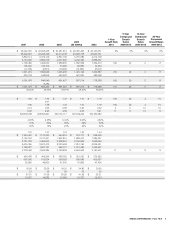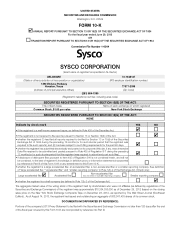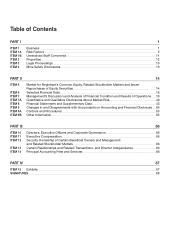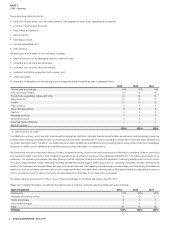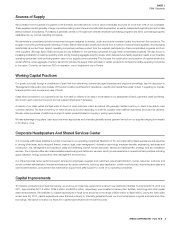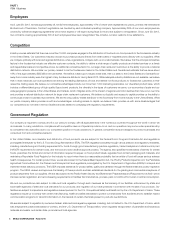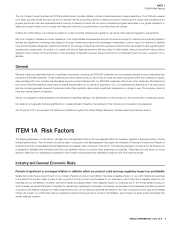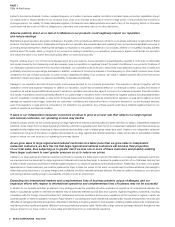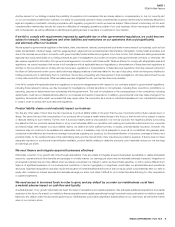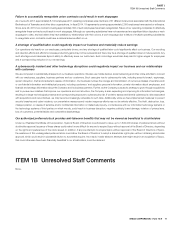Sysco 2013 Annual Report Download - page 17
Download and view the complete annual report
Please find page 17 of the 2013 Sysco annual report below. You can navigate through the pages in the report by either clicking on the pages listed below, or by using the keyword search tool below to find specific information within the annual report.
SYSCO CORPORATION-Form10-K6
PARTI
ITEM1ARisk Factors
Our results and fi nancial condition are directly affected by the volatility in the global economic environment, local
market conditions and low consumer confi dence, which can adversely affect our sales, margins and net income
The foodservice distribution industry is characterized by relatively high inventory turnover with relatively low pro t margins and is especially susceptible to trends
and uncertainty in economic activity, such as the general economic slowdown in the US from 2008 to 2011. The global economic environment has recently been
characterized by weak economies, persistently high unemployment rates, in ationary pressures and volatility in nancial markets worldwide. In addition, our results
of operations are substantially affected by local operating and economic conditions, which can vary substantially by market. The dif cult economic conditions can
affect us in the following ways:
•Unfavorable conditions can depress sales and/or gross margins in a given market.
•
Food cost and fuel cost in ation experienced by the consumer can lead to reductions in the frequency of dining out and the amount spent by consumers
for food-away-from-home purchases which could negatively impact our business by reduced demand for our products.
•
Heightened uncertainty in the nancial markets negatively affects consumer con dence and discretionary spending and can cause disruptions with
our customers and suppliers.
•
Liquidity issues and the inability of our customers, vendors and suppliers to consistently access credit markets to obtain cash to support operations
can cause temporary interruptions in our ability to conduct day-to-day transactions involving the payment to or collection of funds from our customers,
vendors and suppliers.
The uncertainty in the global economic environment has adversely affected both business and consumer con dence and spending, and uncertainty about
the long-term investment environment could further depress capital investment and economic activity.
Competition in our industry may adversely impact our margins and our ability to retain customers, and makes it
diffi cult for us to maintain our market share, growth rate and profi tability
The foodservice distribution industry is highly competitive, with numerous regional and local competitors, and is a mature industry characterized by slowing
revenue growth. Additionally, increased competition from non-traditional sources (such as club stores and commercial wholesale outlets with lower cost
structures), group purchasing organizations or consolidation among competitors have served to further increase pressure on the industry’s pro t margins,
and continued margin pressure within the industry may have a material adverse impact on our operating results and pro tability. New and increased
competitive sources may result in increased focus on pricing and on limiting price increases, or may require increased discounting. Such competition may
result in margin erosion and/or make it dif cult for us to attract and retain customers.
Although our sales historically have grown faster than the market, in recent years we have experienced slowing revenue growth rates. These trends have
placed pressure on our pro t margins and made it more dif cult to achieve growth and pass along cost increases. We expect these trends to continue for
the foreseeable future. If we are unable to effectively differentiate ourselves from our competitors, our market share, sales and pro tability, through increased
expenditures or decreased prices, could be adversely impacted.
We may not be able to fully compensate for increases in fuel costs, and forward purchase commitments intended to
contain fuel costs could result in above market fuel costs
The price and supply of fuel can uctuate signi cantly based on international, political and economic circumstances, as well as other factors outside our
control, such as actions by the Organization of the Petroleum Exporting Countries, or OPEC, and other oil and gas producers, regional production patterns,
weather conditions and environmental concerns. On average, on-highway diesel fuel prices increased approximately 2% and 14% in scal 2013 and 2012,
respectively, as compared to the prior year. Volatile fuel prices have a direct impact on our industry. The cost of fuel affects the price paid by us for products
as well as the costs incurred by us to deliver products to our customers. Although we have been able to pass along a portion of increased fuel costs to our
customers in the past, there is no guarantee that we can do so again if another period of high fuel costs occurs. If fuel costs increase again in the future,
we may experience dif culties in passing all or a portion of these costs along to our customers, which may have a negative impact on our business and
our pro tability. We routinely enter into forward purchase commitments for a portion of our projected monthly diesel fuel requirements at prices equal to
the then-current market price for diesel. If fuel prices decrease signi cantly, these forward purchases may prove ineffective and result in our paying higher
than market costs for a portion of our diesel fuel.
Business and Operational Risks
Our ability to meet our long-term strategic objectives to grow the profi tability of our business depends largely on the
success of the Business Transformation Project
Our multi-year Business Transformation Project consists of:
•
the design and deployment of an Enterprise Resource Planning (ERP) system to implement an integrated software system to support a majority of our
business processes and further streamline our operations;




